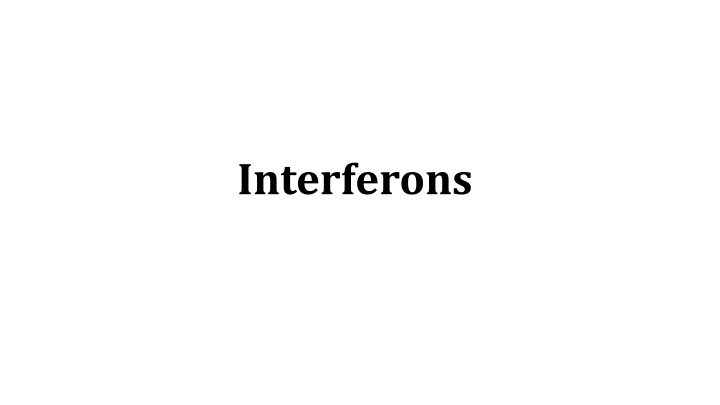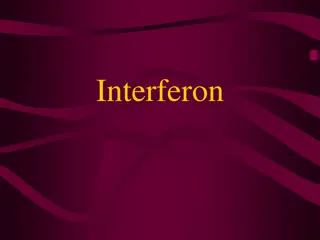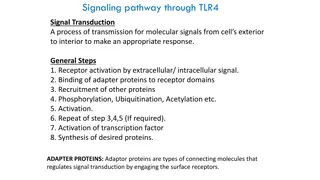Interferons
Interferons (IFNs) are proteins crucial for immune defense against pathogens and tumors. They help cells communicate to trigger immune responses, such as activating natural killer cells and enhancing antiviral defenses. IFNs come in different classes, with Type I IFNs playing a key role in innate immune responses against viral infections. Learn about the types and functions of interferons in the body.
Download Presentation

Please find below an Image/Link to download the presentation.
The content on the website is provided AS IS for your information and personal use only. It may not be sold, licensed, or shared on other websites without obtaining consent from the author.If you encounter any issues during the download, it is possible that the publisher has removed the file from their server.
You are allowed to download the files provided on this website for personal or commercial use, subject to the condition that they are used lawfully. All files are the property of their respective owners.
The content on the website is provided AS IS for your information and personal use only. It may not be sold, licensed, or shared on other websites without obtaining consent from the author.
E N D
Presentation Transcript
Interferons (IFNs) are proteins made and released by host cells in response to the presence of pathogens such as viruses, bacteria, parasites or tumor cells. They allow for communication between cells to trigger the protective defenses of the immune system that eradicate pathogens or tumors. IFNs belong to the large class of glycoproteins known as cytokines [Broad and loose category of small proteins (~5 20 kDa) that are important in cell signaling. They are released by cells and affect the behavior of other cells, and sometimes the releasing cell itself.
Cytokines include chemokines, interferons, interleukins, lymphokines, tumor necrosis factor]. Interferons are named after their ability to "interfere" with viral replications within host cells. IFNs have other functions: They activate immune cells, such as natural killer cells and macrophages They increase recognition of infection or tumor cells by up- regulating antigen presentation to T lymphocytes
They increase the ability of uninfected host cells to resist new infection by virus. Certain symptoms, such as aching muscles and fever, are related to the production of IFNs during infection. About ten distinct IFNs have been identified in mammals; seven of these have been described for humans.
TYPES OF INTERFERON They are typically divided among three IFN classes based on the type of receptor through which they signal: 1. Type I IFN 2. Type II IFN 3. Type III IFN IFNs belonging to all IFN classes are very important for fighting viral infections.
Interferon type I All type I IFNs bind to a specific cell surface receptor complex known as the interferon- / receptor that is made of two chains; IFNAR1 and IFNAR2. Binding of cytokine follows a JAK-STAT signaling pathway. The type I interferons present in humans are; IFN alpha, IFN beta, IFN epsilon ( ), IFN omega ( ) and are produced by leukocytes (WBC; Neutrophils, Eosinophil, Basophil, Lymphocytes (B and T cells) and monocytes).
They are mainly involved in innate immune response against viral infection. The genes for these IFN- molecules are found together in a cluster on chromosome 9. IFN- is also made synthetically as medication. Types are: Pegylated interferon alfa-2a (used to treat chronic hepatitis B and C infection) Pegylated interferon alfa-2b (used to treat chronic hepatitis C infection)
Interferon type II The interferon-gamma receptor (IFNGR) is a receptor that binds interferon- , the sole member of interferon type II. The receptor consists of IFNGR1 and IFNGR2 chains. IFN- proteins are produced in large quantities by fibroblasts. They have antiviral activity that is involved mainly in innate immune response. A fibroblast is a type of cell that synthesizes the extracellular matrix and collagen, the structural framework for animal tissues, and plays a critical role in wound healing.
Interferon type III They signal through a receptor complex consisting of IL10R2 (also called CRF2-4) and IFNLR1 (also called CRF2-12). Acceptance of this classification is less universal than that of type I and type II, and unlike the other two, it is not currently included in Medical Subject Headings.
Interferon alpha binds to type I interferon receptors (IFNAR1 and IFNAR2c) which, upon dimerization, activate two Jak (Janus kinase) tyrosine kinases (Jak1 and Tyk2). These transphosphorylate themselves and phosphorylate the receptors. The phosphorylated INFAR receptors then bind to Stat1 and Stat2 (signal transducers and activators of transcription)which dimerize and combine with P48 protein and activate multiple (~100) immunomodulatory and antiviral proteins. Interferon alpha binds less stably to type I interferon receptors than interferon beta.
The complex of Stat1, Stat2 and P48 moves to nucleus and turn on gene transcription. One of the important enzyme produced is 2 ,5 oliogoadenylate synthetase. When a retrovirus enters a cell, the double stranded viral RNA helps activate 2 ,5 oliogoadenylate synthetase. This leads to the activation of an RNase through the dimerization of its two components. The Rnase diners is then responsible for degradation of viral RNA





